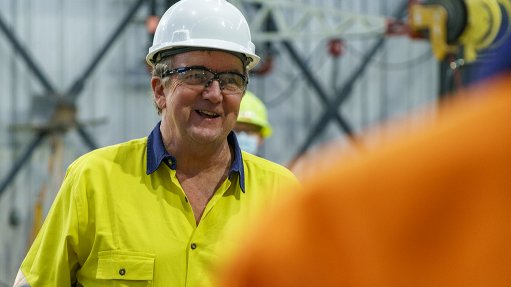
Barrick Gold Corporation CEO Dr Mark Bristow.
The competitive position of gold and copper mining company Barrick is being progressively boosted by exploration, which results in the company replacing extracted ore with similar quality.
“We’re the only company that has replaced our ounces at the same quality through exploration – through the drill bit – and today we’re a much more competent explorer than we were in 2019,” Barrick CEO Dr Mark Bristow, himself a renowned geologist, enthused in an interview.
Barrick has geologists who are capable of delivering copper or gold or both in every single global geological province, except eastern Russia.
Bristow was speaking to Engineering News & Mining Weekly after the New York- and Toronto-listed gold and copper company reported that it remains on track to achieve its 2022 production guidance.
In the three months to the end of September, Barrick overcame some short-term operational challenges and rising input costs, driven largely by what Bristow concedes was a soft production quarter, but one which has paved the way for a stronger final three months, driven by access to higher grades at Nevada Gold Mines.
Overall, it is the exploration drive that is continuing to build momentum and Barrick is set once again to grow its reserves net of depletion this year – but with inflation still a factor needing to be taken into account.
“Inflation is here and you can’t deny it. Many people are wishing it away, just like back in 2008, in the global financial crisis.
“The real impact of the global financial crisis was only really felt in 2011, and that’s when gold went up to $1 /oz.
“In the medium term, it’s great for gold, and, on the copper side, which is the most strategic metal, the market just gets tighter and tighter because, again, the industry has stopped investing in itself just because the copper price is at $3.40/lb – and the gold industry is stretching a bit because it hasn’t replaced the gold that it has mined with similar quality,” Bristow noted.
Helping to keep down costs and mitigating against inflation, too, has been Barrick’s disposal of the noncore assets after its multiple transactions of 2019 and 2020.
A lot of other companies kept everything and took the ride on the high commodity prices, which have since come down amid costs going up, not only driven by inflation and increased input costs, but also lower revenues because of declining grades.
The industry, in Bristow’s view, has spent far too much time rearranging far too few assets amongst too many management teams – “and the problem is that consolidation is even more challenging because there are not enough assets available to build the relevance that this mining industry needs, to be able to participate in a bigger, more developed world.
“So, not only are we dealing with a critical global financial crisis, but it’s materially compounded by the geopolitical mess that we find ourselves in, on a global basis, and then compromised by populist politics and very liberal fiscal doctrine,” he outlined.
Barrick’s asset portfolio and pipeline of organic growth prospects is extensive.
Ongoing exploration in Lumwana, in Zambia, is pointing to the potential for a superpit which could extend the mine’s life to 2060.
At Nevada Gold Mines, the North Leeville target has reported a maiden inferred resource of 700 000 oz, positioning it for further growth.
Key structures in the Loulo district of Mali are indicating the potential for further discoveries and Kibali in the Democratic Republic of Congo continues to deliver growth.
The public comment phase of Nevada Gold Mines’ Goldrush project has been completed and the Pueblo Viejo expansion project in the Dominican Republic is designed to extend the life of the mine beyond 2040 at a production rate of more than 800 000 oz/y of gold.
The definitive agreements on the Reko Diq copper/gold project in Pakistan have been finalised, with potential production from 2027/28.
Third-Quarter Performance
Barrick’s third-quarter operating cash flow of $758-million was supplemented by the sale of noncore royalty assets.
The robust balance sheet supported a $0.10-a-share base dividend plus a $0.05-a-share performance dividend for a total of $0.15 a share for the quarter.
Under the $1-billion share buyback programme, $322-million of shares have been repurchased to date, or about 1% of Barrick’s issued and outstanding shares at the time the programme was announced.